The Resplendent Quetzal
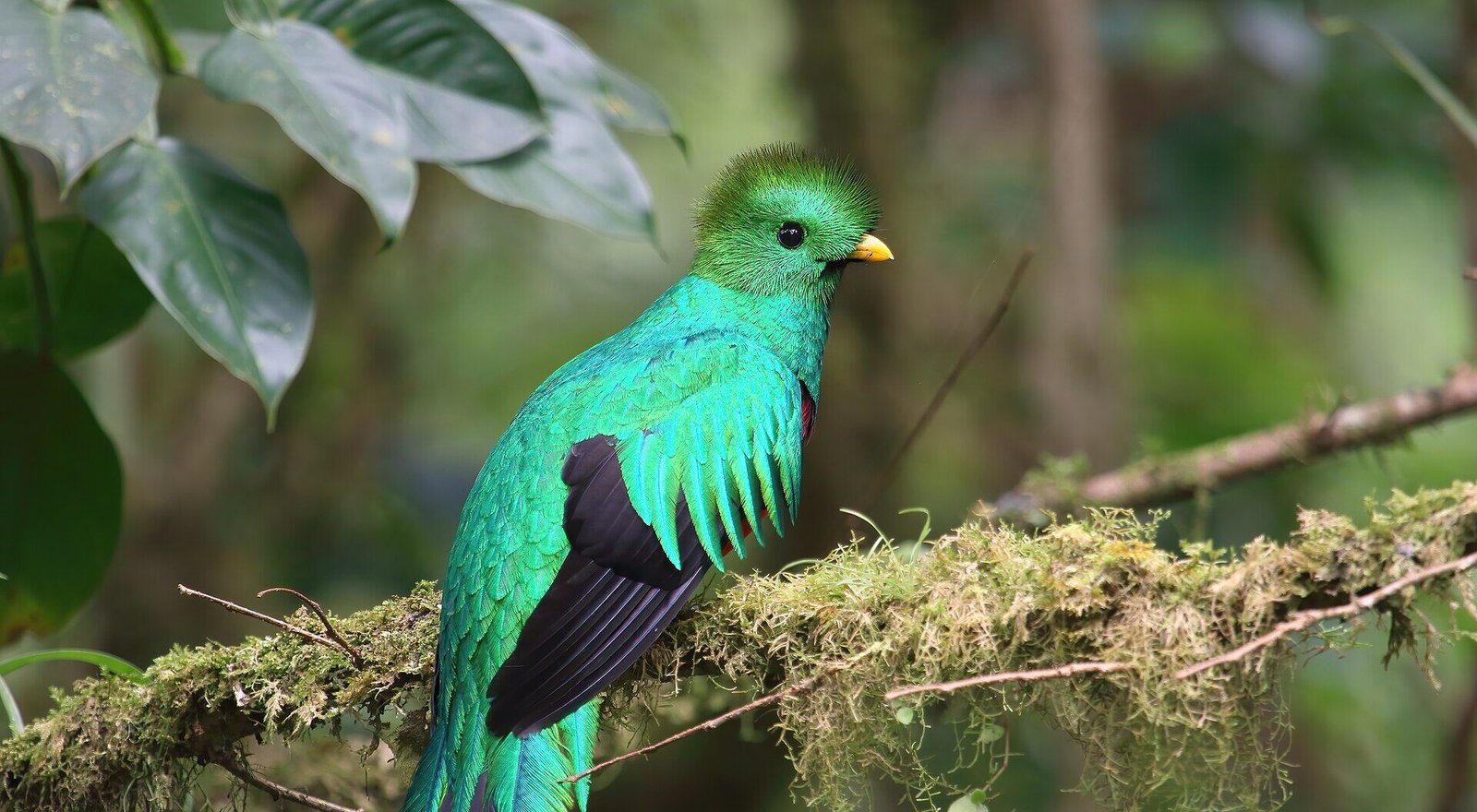
This brilliant bird is a very special resident of Costa Rica’s jungle-covered mountain ranges, and its colorful plumage is not the only thing that makes it noteworthy. Did you know that the Resplendent Quetzal was revered by both the Aztecs and Maya people, with the brilliant green feather being used as a means of exchange or to adorn the clothing of high ranking members like priests and royalty? Even to this day, Guatemala’s currency is called ‘the Quetzal’. This bird is also closely associated with the Aztec deity, Quetzalcōātl. Its rich history, blending ancient reverence and modern fascination, is yours to discover in our latest article. Don’t miss this captivating journey into the heart of the Quetzal’s lore!
‘Resplendent‘ = “attractive and impressive through being richly colorful or splendid and expensive-looking“.
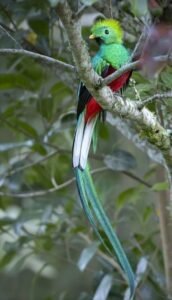
WHAT MAKES THE QUETZAL SO REVERED?
Easy answer – the shimmering plumage, and especially the super-long tail feathers which can make up 2/3 or more of the bird’s total length. Some tail feathers have been measured to over 1m in length, but the usual size is about 75cm in the northern subspecies and 63cm in the southern subspecies.
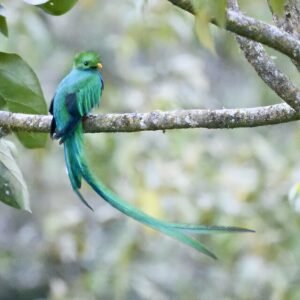
And the first residents of the area had similar ideas – both the Maya and the Aztec held the Resplendent Quetzal in high regard, and not only because of the shimmering tail feathers. The Quetzal does not do well in captivity, so it was celebrated as a symbol of liberty and freedom. As such, keeping or killing Quetzals was not allowed by neither the Mayan nor Aztec people – the birds were captured, stripped of their tail feathers and promptly released back into the wild. Even the word ‘Quetzal’ held meaning – in many local languages it could also be translated as ‘precious’, ‘sacred’, or ‘king’, ‘warrior’, or ‘prince’. Rulers, priests, and other important members of the Mayan and Aztec civilizations often adored their headdresses and clothing with Quetzal feathers while the same feathers were also used as a form of currency.
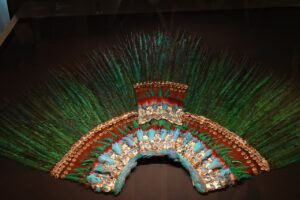
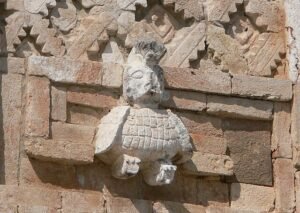
One Mayan legend speaks of the Quetzal accompanying a prince, Tecún Umán, during his fight against the conquistador Pedro de Alvarado. Tecún was armed with a bow and arrow – and with a precise strike, he took out Pedro’s horse. Pedro acquired a second horse and charged at Tecún in retaliation, striking his chest with a spear. it is said that at that very moment, a Quetzal flew down and settled on Tecún’s body, covering its chest with Tecún’s blood. And so the, until then, totally green Quetzal acquired the characteristic red belly coloring. It was also at this time that the Quetzal lost its beautiful song and will not regain its singing ability until the land is fully liberated.
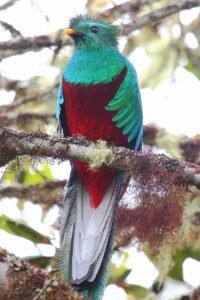
The Aztecs also revered the Quetzal as a god of corn, for a very interesting reason – the Quetzal’s ability to forecast rain! The Quetzals like to start nesting right before the annual wet season rains arrive, as the frogs which multiply in the rains make perfect food for their chicks. And so the Aztecs were very mindful of the Quetzal nesting patterns and thanked the Quetzal for bringing the rains which sustained their corn crops.
ALL ABOUT THE QUETZAL
The Resplendent Quetzal’s name comes from the Aztec Nahuatl language and means, roughly, ‘tall upstanding plume’. The birds are considered small, standing at 38 cm plus a 75cm tailfeathers (northern subspecies) and 32 cm long plus 63cm tailfeathers (southern subspecies, the ones in Costa Rica and Panama). The tailfeathers vary in length and in some cases may be over 1m long. The males and females show a lot of contrast in their plumage. Males have iridescent green plumes, a fiery red breast and belly, black inner wings and a white undertail, while the females are much duller with shorter tail feathers and a grey coloring on the underside.
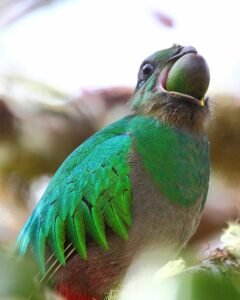
The Quetzals developed very thick plumage – this is because they need to protect their very thin skin. Their eyes are huge in order to help them see in the dark forest environment, as the clowd forests are not only thick but also they often rest under a blanked of clouds and mists. The Quetzal song is an array of full-toned, mellow, slurred notes and is often remarkably melodious: keow, kowee, keow, k’loo, keeloo.
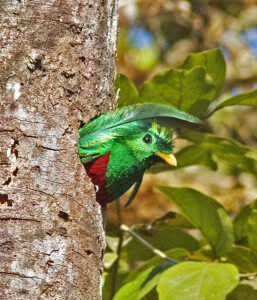
Quetzals like to nest high up in the canopy, preferring hollows left over by woodpeckers or old rotten stumps that are soft enough to be carved with their relatively weak bills. Their diets includes a variety of fruit and nuts – in fact they are heralded as one of the most important birds in the rainforest as they help to spread the seeds of at least 32 species of trees. Their chicks are fed a more diverse diet of insects, lizards, small frogs, snails and some fruit and nuts. Once out of the nest, the youngsters may have to wait up to three years until their tailfeathers grow to the full size.
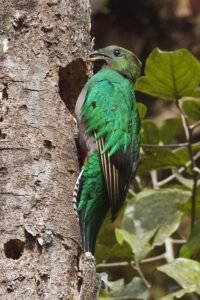
WHERE TO FIND THE QUETZAL IN COSTA RICA
The Quetzal ranges from southern Mexico down through Guatemala, Honduras, Nicaragua and towards the southern end of its range in Costa Rica and Panama. Their range is somewhat fragmented because the birds prefer to live up in the mountains – they are generally not found below 1,000 meters (3,300 feet), with the upper limit of their habitat ascending to over 3,000 meters (10,5000 feet) – although it may migrate lower at certain times. So in Costa Rica they will not usually be found along the coasts but only up in the cloud forests of the central spine. The best places to catch a glimpse are the national parks and protected areas: Monteverde Cloud Forest Reserve, Braulio Carrillo National Park, the aptly named Quetzales National Park, and especially a small mountain village famous for abundant Quetzal – San Gerardo de Dota. Costa Rica is known as the best country to see the Quetzal as we have more and better-managed protected cloud forest areas in prime Quetzal habitat.
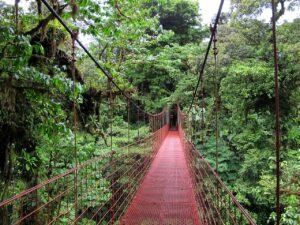
The protected areas are especially important as they contain old growth trees necessary for successful Quetzal breeding – the birds like to nest in tree hollows left over by woodpeckers at least 10 meters, or 30 feet, above ground level. Dead trees are preferred as their wood is softer and the Quetzals can use their weak bill to enlarge or reshape the hollows; live trees are much too hard for them to work with.
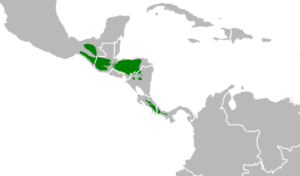
Interestingly, the Quetzal is largely absent from Nicaragua – this is due to a geographical feature called the ‘Nicaraguan Depression’, a 600 km long stretch of low ground which contains Nicaragua’s great lakes. Because Quetzals need high mountain habitat to live and breed, this gap has split the population to the point that two subspecies have been recognized – those Quetzals that live north of Nicaragua belong to the mocinno subspecies, while those that live in Costa Rica and Panama belong to the costaricensis subspecies.
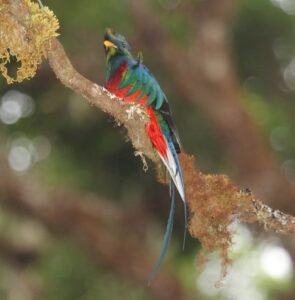
THEY LOVE THE QUETZAL IN GUATEMALA!
As mentioned earlier, the ‘Quetzal’ is the name of the Guatemalan currency. Not only that, the bird appears on the Guatemalan Coat of Arms and its National Flag. Quetzaltenango is also a name of a large city and department, and several other smaller cities bear the ‘Quetzal’ name. Due to the Mayan heritage and the many local Quetzal related legends, the Quetzal plays a big part in the lives of the Guatemalan people, even to this day.
The Resplendent Quetzal is the national bird of Guatemala and, as the legend goes, it was chosen because the bird is said to die in captivity, meaning it would rather die than lose its liberty and freedom. Traditional beliefs also state that the Quetzal is the spirit guide of a Mayan prince and hero, Tecún Umán, who fought against the Spanish conquistadores.
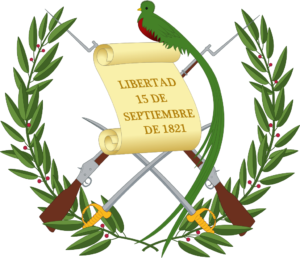
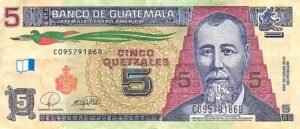
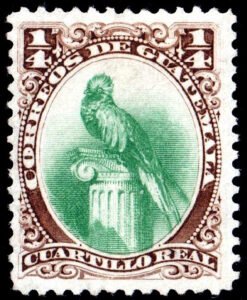
QUETZALCOATL
You cannot talk about the Resplendent Quetzal and not mention Quetzalcōātl, the Aztec deity whose name translates to ‘Feathered Serpent’ – basically, a giant serpent covered in Quetzal feathers. Also worshipped by the Mayans (as the god Kukulkan) and by the more ancient culture of Teotihuacan, as well as many other Mesoamerican peoples, the feathered serpent deity is very far-reaching.
For the Aztec, Quetzalcōātl was a god of many things, and a title of ‘Quetzalcōātl‘ was bestowed onto the highest of priests, but of note is that the deity was considered a ruler of rain gods, and a god of corn – which connects it to the Quetzal which, as we mentioned, was also considered to be a deity associated with rain and corn due to the bird’s uncanny ability to forecast the rains which nourished the Aztec corn fields.
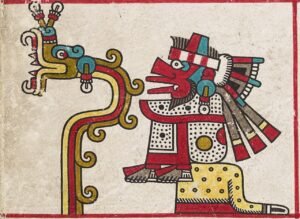

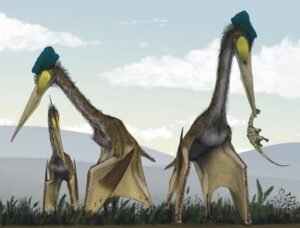
NOT JUST YOUR REGULAR JUNGLE BIRD!
The Resplendent Quetzal is a bird steeped in beauty, mystery, and ancient legend, and people from all over the world come to Costa Rica to catch a glimpse. And while there are national parks and protected areas where they are often seen, keep an eye out as Quetzal habitat is just a few kilometers away from the bustling Costa Ballena towns! Ojochal, Uvita and Dominical are flanked by coastal mountains that rise to over 1,300m (4,300 feet) – prime Quetzal habitat and you never know if a bird or two decide to visit the lower forests in search of food!
Do you dream of living in the midst of breathtaking tropical scenery and amongst amazing animals like the resplendent Quetzal? At RE/MAX WE SELL PARADISE, we list hundreds of tropical properties – homes, land, farms, estates & businesses – all within a stone’s throw of the amazing rainforests, mountains, beaches and resident exotic animals that make Costa Ballena a world-famous destination. Start your journey to paradise by browsing our property listings here.
All images and graphics courtesy of wikicommons.



